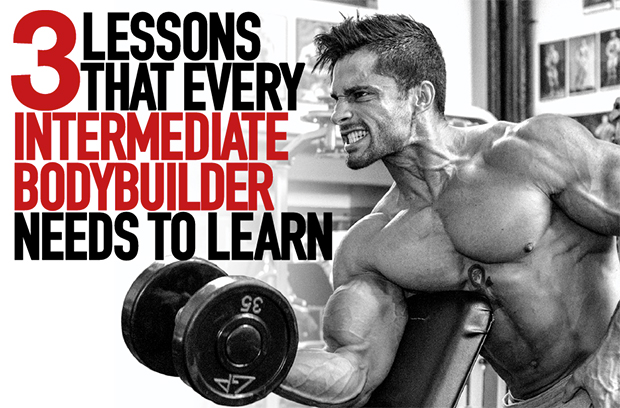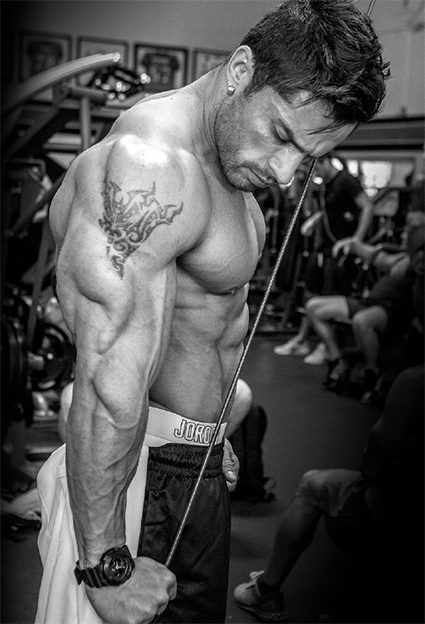3 Lessons Every Intermediate Bodybuilder Needs to Learn

Following a beginner’s program can take you only so far. Here are the most important concepts intermediate lifters should learn to continue making big-time gains and transforming their body.
There’s no graduation day with cap-and-gown ceremony when you decide to take your training to the next level. When you decide you want to further the gains you made as a beginning lifter, however, you’ll have to make some conscious changes to your training program because that starter protocol is increasingly ill-suited the further you progress.
What are the biggies? Here are three key lessons you’ll want to incorporate as an intermediate-level bodybuilder looking to continue making gains.
1. Add Volume and Reduce Frequency to Further Growth

Many first-year programs are centered around learning basic movement patterns and replicating them over and over again until each becomes second nature. Over time, your body adapts to the stresses you created, initially through motor adaptations as you become more coordinated and later through actual gains in muscle size and strength. Because of such adaptation, you need to increase the amount of workyou do on each major body part.
Whereas a beginner might do one or two leg exercises, an intermediate bodybuilder should add more by including another one or two movements that work the lower body from different angles. Say your routine consisted of squats and leg extensions; you could add leg presses and lunges, or other exercises. The added volume allows you to work the lower-body musculature more fully, giving you better overall development.
While adding sets increases your daily training volume (a factor that’s directly linked to muscle growth), it also lengthens your workout. Doubling the number of exercises you do more or less doubles the length of your workout. What’s more, the extra work leads to greater next-day muscle soreness (called DOMS), meaning you’ll be sore longer and your muscle recovery takes longer.
In response, you’ll want to decrease the frequency in which you train a given muscle group. So instead of doing a full-body workout three times a week with roughly 48 hours between workouts, for example, you could split your training into upper- and lower-body workouts or even cover the entire body in three sessions. (Often, this is arranged by doing by “push” muscle groups—shoulders, chest and triceps—on one day, “pull” muscles—back and biceps—the next, and legs on day three.)
This arrangement allows you to train each body part twice a week or every three or four days, enabling you to do more work for each muscle group without extending your daily gym time significantly. That added volume is tempered by a downtick in frequency for each body part. Realize, also, you’ll also be in the gym more times each week.
2. Learn Variations of Your Favourite (and Least-Favourite) Exercises

As mentioned, as a beginner you practiced basic movement patterns perhaps with machines first and then free weights. As you advance, however, diminishing returns (as your body adapts) mean you make incrementally less gains the more you repeat the same stimulus. Besides adding volume, one of the smartest ways to both initiate a slightly altered training stimulus and encourage better overall development of a given muscle group is to expand the number of ways you can execute those same movement patterns. That can mean a change of equipment (for practical purposes, those include barbells, dumbbells, cables, and machines, while there’s even some variety among machine manufacturers) as well as how your body is positioned during the movement.
Say you learned how to do a biceps curl with an EZ-bar. That’s a solid exercise and is very similar to the same motion done on cables, with dumbbells, or even on a machine. Here’s how they differ: With dumbbells, each side has to work independently, which forces the weaker side to carry its own load and allows you to bring it up. Often, dumbbells also allow a slightly greater range of motion.
With machines, the movement pathway is controlled, taking the balance component out of the equation, but that trade-off often allows you to use a slightly heavier weight than you normally would. And since brands of machines are somewhat different, using different ones also offers variety.
With cables, the line of pull comes from the siderather than straight down (from gravity), which effectively changes the angle of the load on the muscle.
In summary, each type of equipment has unique advantages and disadvantages, so you’ll want to eventually find ways to include all of them at one time or another for better overall muscular development. And having alternatives in mind can also be especially helpful on those days when the gym is crowded and you need to find ways to work around the crowds.
Hand position can also elicit changes in muscle-recruitment patterns when talking about the EZ-bar curl. (With other body parts, foot and hand position may instead be altered.) For example, taking a wider grip on the bar puts less tension on the biceps’ long head, whereas a closer grip does just the opposite. An overhand grip hits the brachioradialis (on the forearm) more effectively than the underhand grip. (And if you used a neutral “hammer” grip with dumbbells, that would also stress the brachialis, which lies under the biceps, and helps build overall arm size.) You can also do many of those varied hand positions with cables, which hits all those aforementioned muscles from slightly different angles because the line of pull is no longer the same.
In summary, knowing the many variations of a given exercise is something every intermediate should strive to learn not only to navigate a busy gym, but also to stimulate the target muscle in more ways for better overall muscular development.
One last point: By now you probably have favourite body parts (let us guess: chest and arms!) and exercises that you do more often than ones you dislike. That can be problematic over time, however, because you’re more likely to skip the ones you disfavour (just about any leg exercise, perhaps?) and overdo the ones you like doing. For one, that can lead to asymmetrical development, which can be embarrassing, but worse, it can cause stability problems around a joint. The biceps and triceps are antagonist muscles, as are the quads and hamstrings, and abs/lower back. If you overdevelop one muscle relative to the other, the joint can become destabilized and more prone to injury. Hence, while not every exercise is fun or otherwise ripping through your tight T-shirt, suck it up and do what’s necessary to save yourself some grief down the line. And for those movements you hate, try their variations, too.
3. Find Ways to Keep Challenging Yourself

Remember all those crazy-fast gains that seemed to compound week over week that amazed you as a beginner? Perhaps you noticed, maybe you didn’t, but those gains in size and strength don’t continue indefinitely, especially the longer you train. As your body adapts (especially the fast-twitch muscle fibres) to the training stimulus you put before it by growing bigger and stronger, it finds it doesn’t need to make further adaptations if you fail to increase the training stimulus. That is, if you want to continue increasing muscle size and strength, you have to keep pushing yourself harder (by doing more weight or more reps, or reducing between-sets rest time). That’s the idea behindprogressiveoverload, so don’t ever get too comfortable with your training.
In the first two lessons, we saw how increases in volume (and decreases in frequency) and exercise choice can effectively be used to further muscle gains, but in a sense they can be listed under this category, too. Because this topic is so important, it gets called out.
Putting your training on autopilot, then, is a surefire way to spend enormous amounts of time and energy in the gym without going anywhere. Know how your numbers are trending (use a journal or app to record your sets, reps, and weight for a given movement) and if you’ve stopped seeing gains, it may be time to make some small or even larger-scale change in your workout.

Ultimately, how you respond to a training plateau—and manywill come up over the course of your training career—is what separates those who continue making progress from those ultimately give up because of a lack of results. Just showing up isn’t going to do it.
There are any number of variables you can manipulate, including exercise selection and order, volume, intensity (that is, your target rep at muscle failure), rest periods, and even advanced training principles and your training split. Focus on just a few rather than flipping the switch on every one of them all at once. As a rule, changing up your workout every six weeks or so can not only help you continue building muscle, strength or endurance but also help keep your workout interesting and your attitude fresh.

